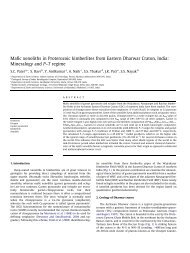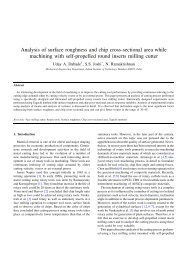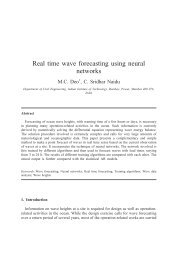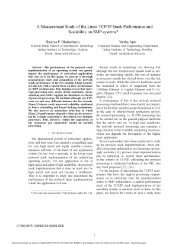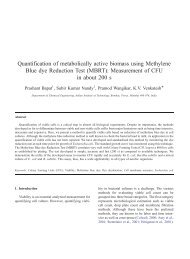Infrared signature studies of aerospace vehicles - DSpace at IIT ...
Infrared signature studies of aerospace vehicles - DSpace at IIT ...
Infrared signature studies of aerospace vehicles - DSpace at IIT ...
You also want an ePaper? Increase the reach of your titles
YUMPU automatically turns print PDFs into web optimized ePapers that Google loves.
(v) The O-subtended by divergent-nozzle is much<br />
larger than th<strong>at</strong> subtended by the convergentsection<br />
and jet-pipe, and is visible over the<br />
complete range <strong>of</strong> f (01–901). Therefore,<br />
considering low IR <strong>sign<strong>at</strong>ure</strong> requirement<br />
from the rear aspect, use <strong>of</strong> divergent-nozzle<br />
for aircraft engine is not a prudent design.<br />
(vi) The nozzle shape can be modified either by—<br />
(a) notching/corrug<strong>at</strong>ing, (b) changing its<br />
aspect r<strong>at</strong>io, or (c) by specifically designed<br />
retr<strong>of</strong>it devices. These modific<strong>at</strong>ions enhance<br />
the mixing <strong>of</strong> exhaust gases with ambient air,<br />
thereby reducing the IR <strong>sign<strong>at</strong>ure</strong> level especially<br />
from the rear aspect.<br />
(vii) Rel<strong>at</strong>ive to the ‘lock-on envelope’, the ‘lethal<br />
envelope’ is a more comprehensive parameter<br />
for target susceptibility assessment. The introduction<br />
<strong>of</strong> the lethal envelope led to the<br />
identific<strong>at</strong>ion <strong>of</strong> a threshold IR <strong>sign<strong>at</strong>ure</strong> level,<br />
above which, IR <strong>sign<strong>at</strong>ure</strong> reduction has no<br />
effect on target susceptibility.<br />
(viii) Minimizing performance penalties associ<strong>at</strong>ed<br />
with engine backpressure, weight, and drag,<br />
due to incorpor<strong>at</strong>ion <strong>of</strong> IR suppression<br />
fe<strong>at</strong>ures is important. These penalties increase<br />
the IR <strong>sign<strong>at</strong>ure</strong> level, because the engine<br />
oper<strong>at</strong>ing point must be shifted to a higher<br />
temper<strong>at</strong>ure for maintaining the output power<br />
required for the mission.<br />
(ix) Emissivity alter<strong>at</strong>ion/optimiz<strong>at</strong>ion <strong>of</strong> radi<strong>at</strong>ing<br />
surfaces are effective tools for IR <strong>sign<strong>at</strong>ure</strong><br />
suppression, especially because imposed performance<br />
penalties are minimal.<br />
(x) Imaging IR seekers have diminished the<br />
effectiveness <strong>of</strong> IR flares as IRCMs. Directional<br />
IR jammers (DIRCM) have emerged as<br />
one <strong>of</strong> the potent active IRCMs.<br />
(xi) The development <strong>of</strong> a Missile Approach<br />
Warning System (MAWS) against IR-guided<br />
missiles is a formidable task, considering the<br />
dynamics <strong>of</strong> tactical warfare.<br />
(xii) The emergence <strong>of</strong> IR CCM has made IR<br />
<strong>sign<strong>at</strong>ure</strong> management more intric<strong>at</strong>e and<br />
exigent.<br />
The IR <strong>sign<strong>at</strong>ure</strong>s and associ<strong>at</strong>ed technologies are<br />
significantly shaping the future course <strong>of</strong> developments<br />
in stealth technology and electro-optical (EO)<br />
warfare. There is an exigent need to reduce the<br />
susceptibility <strong>of</strong> aircraft against IR-guided missiles,<br />
particularly after the growing <strong>at</strong>tacks on civilian<br />
aircraft. Modern gener<strong>at</strong>ion comb<strong>at</strong> aircraft may<br />
ARTICLE IN PRESS<br />
not survive the human-made hostile environment, if<br />
they are deficient in IRCMs.<br />
6.1. Scope for future research<br />
241<br />
Most <strong>of</strong> the research in IR <strong>sign<strong>at</strong>ure</strong> analysis is<br />
controlled by military research establishments;<br />
hence, there are limited details in the open academic<br />
liter<strong>at</strong>ure. There is a generic need to develop models<br />
with improved IR <strong>sign<strong>at</strong>ure</strong> prediction capabilities,<br />
followed by experimental valid<strong>at</strong>ion. The capabilities<br />
<strong>of</strong> existing models are far from enabling their<br />
utiliz<strong>at</strong>ion in digital IR simul<strong>at</strong>ors for real-time<br />
evalu<strong>at</strong>ion <strong>of</strong> aircraft susceptibility for decision<br />
making in comb<strong>at</strong>. Such developments would<br />
provide a reasonably reliable estim<strong>at</strong>e <strong>of</strong> the<br />
effectiveness <strong>of</strong> IR flares and IR jammers in<br />
oper<strong>at</strong>ion.<br />
The specific areas in which there is a pressing need<br />
for future academic research are outlined below:<br />
(i) There is virtually no d<strong>at</strong>a in the open liter<strong>at</strong>ure<br />
on measurements <strong>of</strong> IR <strong>sign<strong>at</strong>ure</strong> levels on<br />
oper<strong>at</strong>ional aircraft for various oper<strong>at</strong>ing conditions<br />
and from various angles. Availability <strong>of</strong><br />
such inform<strong>at</strong>ion would serve as bench-mark<br />
cases for academic codes th<strong>at</strong> study the<br />
qualit<strong>at</strong>ive characteristics and trends.<br />
(ii) Labor<strong>at</strong>ory simul<strong>at</strong>ion for IR <strong>sign<strong>at</strong>ure</strong> measurement<br />
is still under development, as there are<br />
issues pertaining to similitude th<strong>at</strong> need to be<br />
resolved. Scaling is an issue considering th<strong>at</strong> IR<br />
<strong>sign<strong>at</strong>ure</strong> level (IRSL) depends on a multitude<br />
<strong>of</strong> parameters th<strong>at</strong> represent several concurrent<br />
mechanisms and phenomena.<br />
(iii) There is limited inform<strong>at</strong>ion in the liter<strong>at</strong>ure on<br />
the prediction <strong>of</strong> IR <strong>sign<strong>at</strong>ure</strong> due to miscellaneous<br />
sources; e.g. earthshine, sunshine, and<br />
skyshine. Their modeling is important for<br />
reducing the uncertainties in IRSL prediction.<br />
(iv) No reported model predicts the effect <strong>of</strong> IRSS<br />
system install<strong>at</strong>ion penalties on increase in<br />
IRSL, due to the shift in engine oper<strong>at</strong>ing<br />
point for maintaining mission power. This<br />
deficiency necessit<strong>at</strong>es the coupling <strong>of</strong> IRSL<br />
prediction models with engine <strong>of</strong>f-design performance<br />
analyses.<br />
(v) For realistic susceptibility assessment, it is<br />
necessary to predict temper<strong>at</strong>ure pr<strong>of</strong>iles over<br />
the entire aircraft skin for different oper<strong>at</strong>ing<br />
conditions. This would enable modelling <strong>of</strong> the<br />
aircraft as a well-resolved distributed source <strong>of</strong>



